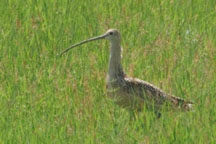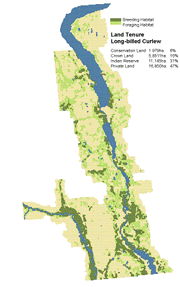|
Habitat Atlas for Wildlife at Risk
Long-billed Curlew
Numenius americanus

Long-billed
Curlew
|
 - Largest sandpiper in the world.
- Length: 50 cm; wingspan: 1 metre.
- Distinctive, down-curved bill is 19 cm long.
- Plumage is sandy brown with cinnamon-coloured
underwings visible during flight.
Status:
British Columbia Blue List
Special Significance
It is believed that there are only a few hundred breeding
pairs of Long-billed Curlews in British Columbia.
Prior to legal protection in early 1900s, Long-billed
Curlews were decimated by hunters in eastern North
America, and were eliminated from many parts of their
range by expansion of agriculture on the plains and
prairies in the 1930s. The Long-billed Curlew has
already disappeared from most parts of eastern Canada
and United States. Landowners can help curlews by
avoiding known nest sites and delaying harvesting
of agricultural fields until late June when the breeding
season is over.
Distribution
- In British Columbia, curlews breed in the Southern Interior; primary
breeding areas are the open grasslands from Williams
Lake west through Alexis Creek, in the Okanagan and lower Similkameen
valleys, in the
East Kootenay Trench, in the Nicola Valley and
near Kamloops; a few pairs breed north along the North Thompson
River to Clearwater and
along the Fraser River near McBride.
- Curlews appear sporadically on the south coast during
migration, but most reach the coast only on the
wintering grounds in California and Mexico.
- Restricted to elevations below 1220 metres, although
breeding grounds are generally below 600 metres.
Habitat
- Curlews frequent grassy terrain, newly-ploughed fields, green
hayfields, meadows and pastures; birds do not have to be near water.
- Nest in open dry grasslands or grain fields with short
vegetation (less than 30 cm high). Nests are depressions
in the ground, usually lined with grasses, bits of cow dung or a
few twigs.
- Seepage areas, hayfields and irrigated fields are used
for foraging and rearing young.
Reproduction
- Curlews arrive in late March to mid-April; birds are seldom seen
in the Okanagan after mid-July.
- Male attracts female with elaborate undulating flight
displays around the perimeter of their territory;
the pair defends a territory of 15 - 24 hectares in size.
- Female lays 3 - 5 eggs in mid-April to early June;
eggs are incubated for 20 days and most young fledge
by mid-July.
- Young are able to run around within hours of hatching;
the nest is abandoned within 24 hours.
Food Habits
- Curlews are omnivorous birds that eat insects, worms, crustaceans,
mollusks, toads, eggs and nestlings of other birds,
and berries.
- Curlews probe deep with their bills into burrows of
insects and other small creatures; they also pick
small invertebrates from the soil and vegetation.
Interesting Facts
- Curlews got their name from their unmistakable call, "curleeuu,
curleeuu, curleeuu. "
- When danger approaches, parents sound an alarm call
telling chicks to "freeze" and hide; parents and neighbouring
birds dive from skies to drive intruders off.
- To avoid detection when threatened on the nest, curlews
lie flat on the ground with their necks stretched
out.
- When resting, curlews point their heads into the wind.
- Pairs sometimes share their nest with another female.
Threats
- Habitat loss due to agriculture and urban development.
- Sensitivity to human disturbance.
- Off-road vehicle use in or near nesting habitat.
Management Considerations
- Protect and maintain suitable habitat such as
open, dry grasslands with short vegetation.
- Protect known breeding sites from human disturbance.
- Delay harvesting of hayfields until after the
bird's nesting season ends in mid-June.
- Avoid driving off-road vehicles through possible
nesting locations.
- Contact your local British Columbia Ministry
of Water, Land and Air Protection if a nest
is located.
|
References
1. Campbell, R.W., N. K. Dawe, I. McTaggart-Cowan, J. Cooper, G.
Kaiser and M.C. McNall. 1990. Birds of British Columbia: Volume 2.
Royal British Columbia Museum,Victoria, BC.
2. Cannings, R.A., R.J. Cannings and S.G. Cannings.
1987. Birds of the Okanagan Valley, British Columbia. Royal British
Columbia Museum, Victoria, BC.
|